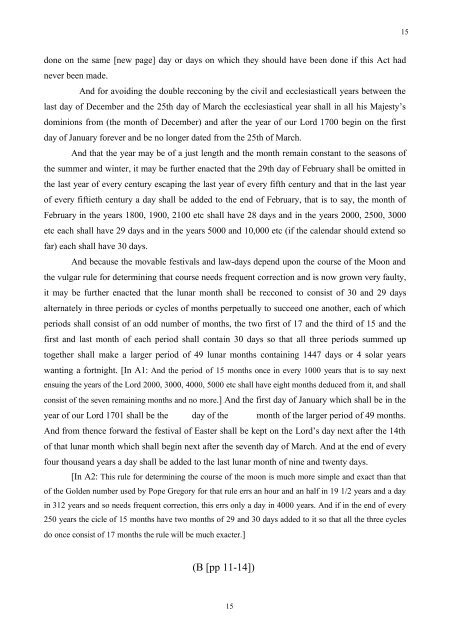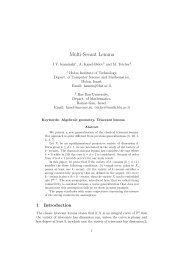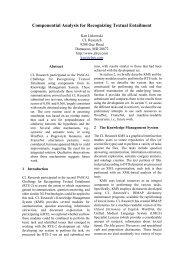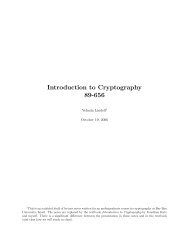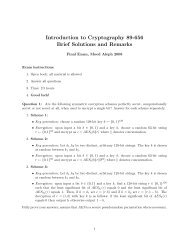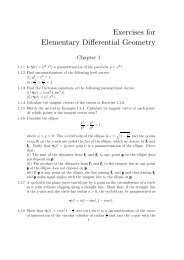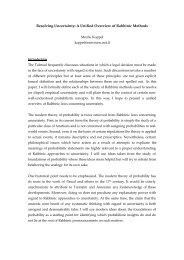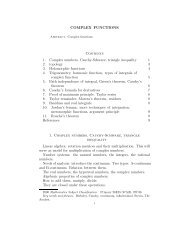Reform of the Julian Calendar as Envisioned by Isaac Newton
Reform of the Julian Calendar as Envisioned by Isaac Newton
Reform of the Julian Calendar as Envisioned by Isaac Newton
You also want an ePaper? Increase the reach of your titles
YUMPU automatically turns print PDFs into web optimized ePapers that Google loves.
15<br />
done on <strong>the</strong> same [new page] day or days on which <strong>the</strong>y should have been done if this Act had<br />
never been made.<br />
And for avoiding <strong>the</strong> double recconing <strong>by</strong> <strong>the</strong> civil and ecclesi<strong>as</strong>ticall years between <strong>the</strong><br />
l<strong>as</strong>t day <strong>of</strong> December and <strong>the</strong> 25th day <strong>of</strong> March <strong>the</strong> ecclesi<strong>as</strong>tical year shall in all his Majesty’s<br />
dominions from (<strong>the</strong> month <strong>of</strong> December) and after <strong>the</strong> year <strong>of</strong> our Lord 1700 begin on <strong>the</strong> first<br />
day <strong>of</strong> January forever and be no longer dated from <strong>the</strong> 25th <strong>of</strong> March.<br />
And that <strong>the</strong> year may be <strong>of</strong> a just length and <strong>the</strong> month remain constant to <strong>the</strong> se<strong>as</strong>ons <strong>of</strong><br />
<strong>the</strong> summer and winter, it may be fur<strong>the</strong>r enacted that <strong>the</strong> 29th day <strong>of</strong> February shall be omitted in<br />
<strong>the</strong> l<strong>as</strong>t year <strong>of</strong> every century escaping <strong>the</strong> l<strong>as</strong>t year <strong>of</strong> every fifth century and that in <strong>the</strong> l<strong>as</strong>t year<br />
<strong>of</strong> every fiftieth century a day shall be added to <strong>the</strong> end <strong>of</strong> February, that is to say, <strong>the</strong> month <strong>of</strong><br />
February in <strong>the</strong> years 1800, 1900, 2100 etc shall have 28 days and in <strong>the</strong> years 2000, 2500, 3000<br />
etc each shall have 29 days and in <strong>the</strong> years 5000 and 10,000 etc (if <strong>the</strong> calendar should extend so<br />
far) each shall have 30 days.<br />
And because <strong>the</strong> movable festivals and law-days depend upon <strong>the</strong> course <strong>of</strong> <strong>the</strong> Moon and<br />
<strong>the</strong> vulgar rule for determining that course needs frequent correction and is now grown very faulty,<br />
it may be fur<strong>the</strong>r enacted that <strong>the</strong> lunar month shall be recconed to consist <strong>of</strong> 30 and 29 days<br />
alternately in three periods or cycles <strong>of</strong> months perpetually to succeed one ano<strong>the</strong>r, each <strong>of</strong> which<br />
periods shall consist <strong>of</strong> an odd number <strong>of</strong> months, <strong>the</strong> two first <strong>of</strong> 17 and <strong>the</strong> third <strong>of</strong> 15 and <strong>the</strong><br />
first and l<strong>as</strong>t month <strong>of</strong> each period shall contain 30 days so that all three periods summed up<br />
toge<strong>the</strong>r shall make a larger period <strong>of</strong> 49 lunar months containing 1447 days or 4 solar years<br />
wanting a fortnight. [In A1: And <strong>the</strong> period <strong>of</strong> 15 months once in every 1000 years that is to say next<br />
ensuing <strong>the</strong> years <strong>of</strong> <strong>the</strong> Lord 2000, 3000, 4000, 5000 etc shall have eight months deduced from it, and shall<br />
consist <strong>of</strong> <strong>the</strong> seven remaining months and no more.] And <strong>the</strong> first day <strong>of</strong> January which shall be in <strong>the</strong><br />
year <strong>of</strong> our Lord 1701 shall be <strong>the</strong> day <strong>of</strong> <strong>the</strong> month <strong>of</strong> <strong>the</strong> larger period <strong>of</strong> 49 months.<br />
And from <strong>the</strong>nce forward <strong>the</strong> festival <strong>of</strong> E<strong>as</strong>ter shall be kept on <strong>the</strong> Lord’s day next after <strong>the</strong> 14th<br />
<strong>of</strong> that lunar month which shall begin next after <strong>the</strong> seventh day <strong>of</strong> March. And at <strong>the</strong> end <strong>of</strong> every<br />
four thousand years a day shall be added to <strong>the</strong> l<strong>as</strong>t lunar month <strong>of</strong> nine and twenty days.<br />
[In A2: This rule for determining <strong>the</strong> course <strong>of</strong> <strong>the</strong> moon is much more simple and exact than that<br />
<strong>of</strong> <strong>the</strong> Golden number used <strong>by</strong> Pope Gregory for that rule errs an hour and an half in 19 1/2 years and a day<br />
in 312 years and so needs frequent correction, this errs only a day in 4000 years. And if in <strong>the</strong> end <strong>of</strong> every<br />
250 years <strong>the</strong> cicle <strong>of</strong> 15 months have two months <strong>of</strong> 29 and 30 days added to it so that all <strong>the</strong> three cycles<br />
do once consist <strong>of</strong> 17 months <strong>the</strong> rule will be much exacter.]<br />
(B [pp 11-14])<br />
15


